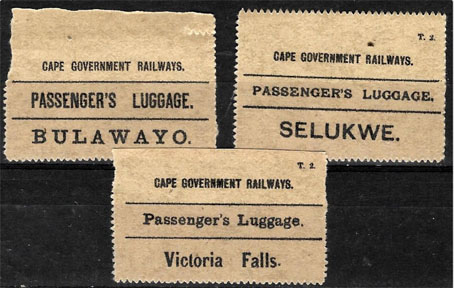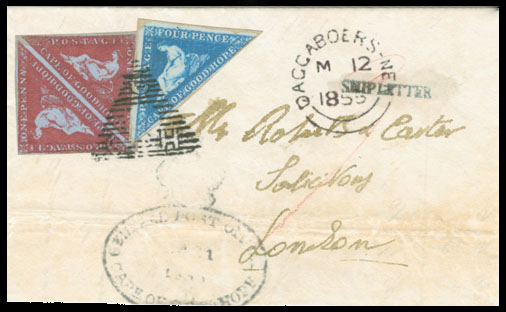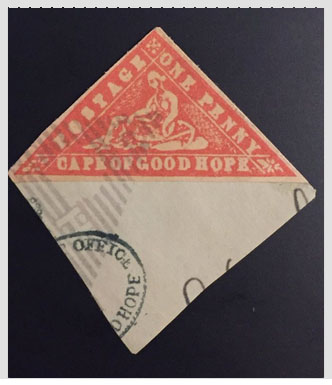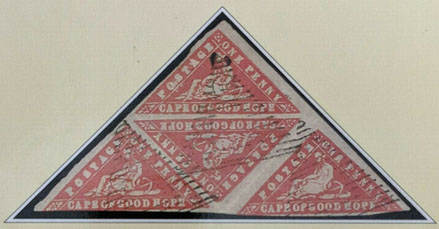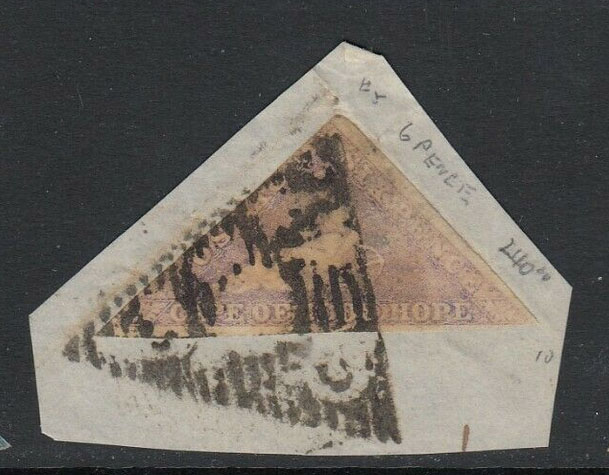Forged Cape of Good Hope Stamps and Covers
Quote from Steve on April 9, 2020, 10:27 amI have an interest in forgers and forged Cape triangles. Most of these were produced as space-fillers for Victorian and Edwardian collectors who could not afford the high price of the real thing. Most of these forgers produced their own fake postmarks to create 'used' Cape triangles. These fanciful cancellers were usually based on a European design.
If you know your early Cape postmarks - only 13 are recorded used on Cape triangles - and you find a triangle cancelled with a postmark that you have never seen used at the Cape before, then the chances are very high that you are looking at a forgery. This method of eliminating forgeries only works if the postmark is a fake. Fortunately, very few if any of the 19th C. forgers attempted to fake genuine Cape postmarks. But modern forgers do!
A modern forger called Saul who operates on Delcampe, the European auction site, and who lives in Italy, is forging used Cape triangles complete with 'genuine' cancellations. Saul currently (09/04/2020) has two offerings up for auction on Delcampe. One lot of two triangles have passable attempts at the COGH Triangular Obliterator and the Barred Circle Numeral Canceller. Saul has kindly described these as "forgeries" while the other lot of Railway Parcel labels he has not. I have a strong feeling that these CGR Passenger's Luggage labels are also not genuine.
If you go onto Delcampe and visit Saul's shop you will see an array of forged material, including some ZAR, all created for the purpose of making money. In many instances he states his work is a 'forgery' but in others he does not. No doubt, he believes he is a good guy who is having a little harmless fun. However, knowingly selling forged items for profit is a criminal offence!
The problem is that forgery collectors like myself buy these items to use as examples and so increase the market for them. I won't be buying any from Saul as I recently bought from a reputable dealer a display of a large number of forgeries that included three pages of his material! Below I include an interesting cover that came from that lot which purports to be from Daggaboersnek.
I have an interest in forgers and forged Cape triangles. Most of these were produced as space-fillers for Victorian and Edwardian collectors who could not afford the high price of the real thing. Most of these forgers produced their own fake postmarks to create 'used' Cape triangles. These fanciful cancellers were usually based on a European design.
If you know your early Cape postmarks - only 13 are recorded used on Cape triangles - and you find a triangle cancelled with a postmark that you have never seen used at the Cape before, then the chances are very high that you are looking at a forgery. This method of eliminating forgeries only works if the postmark is a fake. Fortunately, very few if any of the 19th C. forgers attempted to fake genuine Cape postmarks. But modern forgers do!
A modern forger called Saul who operates on Delcampe, the European auction site, and who lives in Italy, is forging used Cape triangles complete with 'genuine' cancellations. Saul currently (09/04/2020) has two offerings up for auction on Delcampe. One lot of two triangles have passable attempts at the COGH Triangular Obliterator and the Barred Circle Numeral Canceller. Saul has kindly described these as "forgeries" while the other lot of Railway Parcel labels he has not. I have a strong feeling that these CGR Passenger's Luggage labels are also not genuine.
If you go onto Delcampe and visit Saul's shop you will see an array of forged material, including some ZAR, all created for the purpose of making money. In many instances he states his work is a 'forgery' but in others he does not. No doubt, he believes he is a good guy who is having a little harmless fun. However, knowingly selling forged items for profit is a criminal offence!
The problem is that forgery collectors like myself buy these items to use as examples and so increase the market for them. I won't be buying any from Saul as I recently bought from a reputable dealer a display of a large number of forgeries that included three pages of his material! Below I include an interesting cover that came from that lot which purports to be from Daggaboersnek.
Uploaded files:Quote from Steve on August 30, 2020, 1:07 pmI have spotted what I think is another Cape of God Hope Triangle Forgery on the internet. See top image, below. There are hundreds, so buyer beware. This one just happens to be more interesting as someone has gone to some trouble to make it into a very attractive philatelic item on piece by adding fake postmarks to an old space-filler-type forgery.
It is described as a COGH woodblock of 1861. "The item is in excellent condition and would make a great collectors piece". Yes, it will look great in my Cape Forgeries collection but I am not going to pay over £21.00 to buy it simply to document it as a fake, thereby perpetuating the market for fakes. I would rather take fake images from the internet for free. The seller most probably does not know that the item is a questionable. He is most likely innocently and ignorantly selling something he does not understand. There's a lot of that on the internet.
So, why do I think that the topmost the stamp on piece is a forgery. It's largely due to the postmarks.
First, the stamp is one of the better common woodblock space-filler forgeries, easily found 'mint'. If the stamp is a genuine Cape woodblock, I am a rich man. I have acquired several over the years starting in the time when dealers recognised a forgery / space-filler as such and had the integrity to mark it down accordingly. The colour is too orange and fresh, the text is too large, the detail too crude even for a woodblock and the white rock that Hope sits on too large. Is that all, you might ask? No. The second giveaway are the postmarks. These are too good to be true.
Usually, such space-fillers were 'cancelled' with a fake canceller never used at the Cape. These are easily detectable. Worryingly, this one recreates a small triangular obilterator that was used at the Cape. Its small triangular obliterator is perfect. Its light, clean uniformity suggests it was created on a computer and printed out on a printer. Forgeries like these are increasingly seen on the internet.
The second of the three images below is a block of 4 from the Sir Maxwell Joseph collection, an excellent provenance. You will see that the stamps are very similar to the topmost example. What is different is that the light and faint triangular obiterator is not nearly as clean, sharp and unform as the topmost image. The irregularity of this postmark is exactly what you should expect to see in a genuine cancellation.
Bottom below, I have attached an example, also taken from the internet today, of what the triangular obliterator typically looked like after some hard work before it was cleaned. It was not called an 'obliterator' for nothing. It was supposed to obliterate, not be a decorative companion piece to a Cape triangle. I accept that this third image (bottom) has a very heavy cancellation but I believe that it is closer to the reality of Cape triangular usage and obliteration than the pristine, dainty and highly sanitised computer generated postmark in question.
Of course, I might be wrong.
The second postmark on the bottom right of the piece shows just a hint of the oval dated letter stamp which was withdrawn before the introduction of triangular stamps and which is not recorded by D Alan Stevenson, (The Triangular Stamps of the Cape of Good Hope, 1950), as being associated with letters bearing Cape Triangles. The forger known as Saul has used this postmark elsewhere.
I might be wrong about all this and for £21+ that woodblock is a bargain. But I don't think so.
I have spotted what I think is another Cape of God Hope Triangle Forgery on the internet. See top image, below. There are hundreds, so buyer beware. This one just happens to be more interesting as someone has gone to some trouble to make it into a very attractive philatelic item on piece by adding fake postmarks to an old space-filler-type forgery.
It is described as a COGH woodblock of 1861. "The item is in excellent condition and would make a great collectors piece". Yes, it will look great in my Cape Forgeries collection but I am not going to pay over £21.00 to buy it simply to document it as a fake, thereby perpetuating the market for fakes. I would rather take fake images from the internet for free. The seller most probably does not know that the item is a questionable. He is most likely innocently and ignorantly selling something he does not understand. There's a lot of that on the internet.
So, why do I think that the topmost the stamp on piece is a forgery. It's largely due to the postmarks.
First, the stamp is one of the better common woodblock space-filler forgeries, easily found 'mint'. If the stamp is a genuine Cape woodblock, I am a rich man. I have acquired several over the years starting in the time when dealers recognised a forgery / space-filler as such and had the integrity to mark it down accordingly. The colour is too orange and fresh, the text is too large, the detail too crude even for a woodblock and the white rock that Hope sits on too large. Is that all, you might ask? No. The second giveaway are the postmarks. These are too good to be true.
Usually, such space-fillers were 'cancelled' with a fake canceller never used at the Cape. These are easily detectable. Worryingly, this one recreates a small triangular obilterator that was used at the Cape. Its small triangular obliterator is perfect. Its light, clean uniformity suggests it was created on a computer and printed out on a printer. Forgeries like these are increasingly seen on the internet.
The second of the three images below is a block of 4 from the Sir Maxwell Joseph collection, an excellent provenance. You will see that the stamps are very similar to the topmost example. What is different is that the light and faint triangular obiterator is not nearly as clean, sharp and unform as the topmost image. The irregularity of this postmark is exactly what you should expect to see in a genuine cancellation.
Bottom below, I have attached an example, also taken from the internet today, of what the triangular obliterator typically looked like after some hard work before it was cleaned. It was not called an 'obliterator' for nothing. It was supposed to obliterate, not be a decorative companion piece to a Cape triangle. I accept that this third image (bottom) has a very heavy cancellation but I believe that it is closer to the reality of Cape triangular usage and obliteration than the pristine, dainty and highly sanitised computer generated postmark in question.
Of course, I might be wrong.
The second postmark on the bottom right of the piece shows just a hint of the oval dated letter stamp which was withdrawn before the introduction of triangular stamps and which is not recorded by D Alan Stevenson, (The Triangular Stamps of the Cape of Good Hope, 1950), as being associated with letters bearing Cape Triangles. The forger known as Saul has used this postmark elsewhere.
I might be wrong about all this and for £21+ that woodblock is a bargain. But I don't think so.
Uploaded files:Quote from Steve on September 5, 2020, 10:19 amI wrote the above immediately after seeing the piece for sale on the internet. I have just looked at my notes and accumulation. The above orange penny appears to be a Jurgens woodblock reprint, by itself quite collectable as a piece of 'Jurgensiana'. Were the postmarks added by Jurgens? I doubt it. He would have created a handstamp to get the necessary effect. (Such a result would have been more convincing!) This is so perfectly uniform as to be unnatural ie. computer generated. I have looked to see if I have genuine STO examples as clear, sharp and uniform and have only one that comes close but whose ink is darker, breaks up and fades away over part of the stamp. So, in my opinion the stamp is a reprint from the original dies with the additional embellishment of modern fake postmarks. If true, that piece is developing a philatelic history all of its own and as a result may be worth something after all.
I wrote the above immediately after seeing the piece for sale on the internet. I have just looked at my notes and accumulation. The above orange penny appears to be a Jurgens woodblock reprint, by itself quite collectable as a piece of 'Jurgensiana'. Were the postmarks added by Jurgens? I doubt it. He would have created a handstamp to get the necessary effect. (Such a result would have been more convincing!) This is so perfectly uniform as to be unnatural ie. computer generated. I have looked to see if I have genuine STO examples as clear, sharp and uniform and have only one that comes close but whose ink is darker, breaks up and fades away over part of the stamp. So, in my opinion the stamp is a reprint from the original dies with the additional embellishment of modern fake postmarks. If true, that piece is developing a philatelic history all of its own and as a result may be worth something after all.


